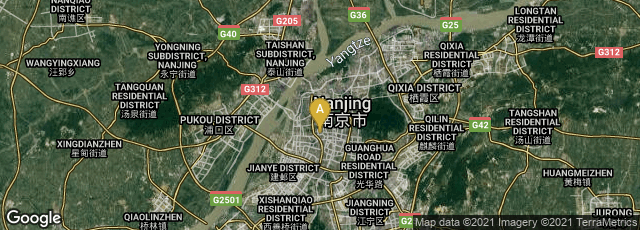

A: Gulou Qu, Nanjing Shi, Jiangsu Sheng, China
In 1633 Chinese artist, calligrapher, seal-carver, publisher and bookseller Hu Zhengyan (胡正言) issued the Shi zhu zhai shu hua pu (Ten Bamboo Studio Collection of Calligraphy and Painting) from his Ten Bamboo Studio in Nanjing. The work, developed and printed from 1619 to 1633, included works in eight subject categories illustrated by 50 different artists and calligraphers, with birds, plums, orchids, bamboo, fruit, stones, ink drawings, and other miscellaneous imagery, each followed by a text or poem. It was the earliest painting manual in China to be printed in color, and the first to include isolated illustrations of subject matter from nature. For the images Hu Zhengyan selected works of both contemporary and historical artists. The complete work includes 185 pictorial leaves and 139 calligraphy leaves. According to a press release issued by The Huntington Library on July 31, 2014, 18 complete copies of the first edition have survived, all in varying condition.
"By repeatedly studying and copying the models, Hu not only developed an acute sense of each artist's characteristic brush manner and compositional style for transfer onto woodblocks, he was also able to determine the appropriate color palettes and nuances of shading for every potential print.
"....A separate block was made for each color in a technique known as taoban ('set of blocks' or 'overlaid blocks') or douban ('assembled blocks' or 'decorative blocks'). The most luxurious editions of this manual incorporated the gonghua ('embossed design' or 'arched 'pattern', known in the West as gauffrage or gongban ('embossed blocks' or 'arched blocks') method, a blind-stamping technique whereby illustrations with exquisite low-relief designed were produced by pressing the paper firmly against a dry, uninked engraved woodblock. The douban technique was espeically time-consuming as numerous individual woodblocks were required for a single print. In addition, matching plates carved in intaglio and in relief were combined to produce the gonghua effect. The readied blocks were then placed in exactly the right positions and color was applied according to the hues and gradations in the model. Finally, the images were printed on flattened, slightly mostened paper in temperature-and humidity-controlled workshops. The best editions were printed on very high-quality langgan ('pearled') paper produced by Hu Zhengyan.
"The engraving was so skillfully done that virutally no stray marks from, or outlines of the cut blocks, are to be seen in finely printed editions of the manual. As a result, illustrations in the Shizhu zhai shuahua pu appear as though painted by hand" (Philip K. Hu, Visible Traces. Rare Books and Special Collections from the National Library of China (2000) No. 15).
Digital facsimile of a complete copy of the Shi zhu zhai shu hua pu from the Cambridge Digital Library at this link.
The manual was printed and reprinted for at least two hundred years, resulting in a very complex bibliographical record. See Thomas Ebrey, "The Editions, superstates and states of the Ten Bamboo Studio Collection of Calligraphy and Painting", East Asian Library Journal, 14 (2010) 1-119.